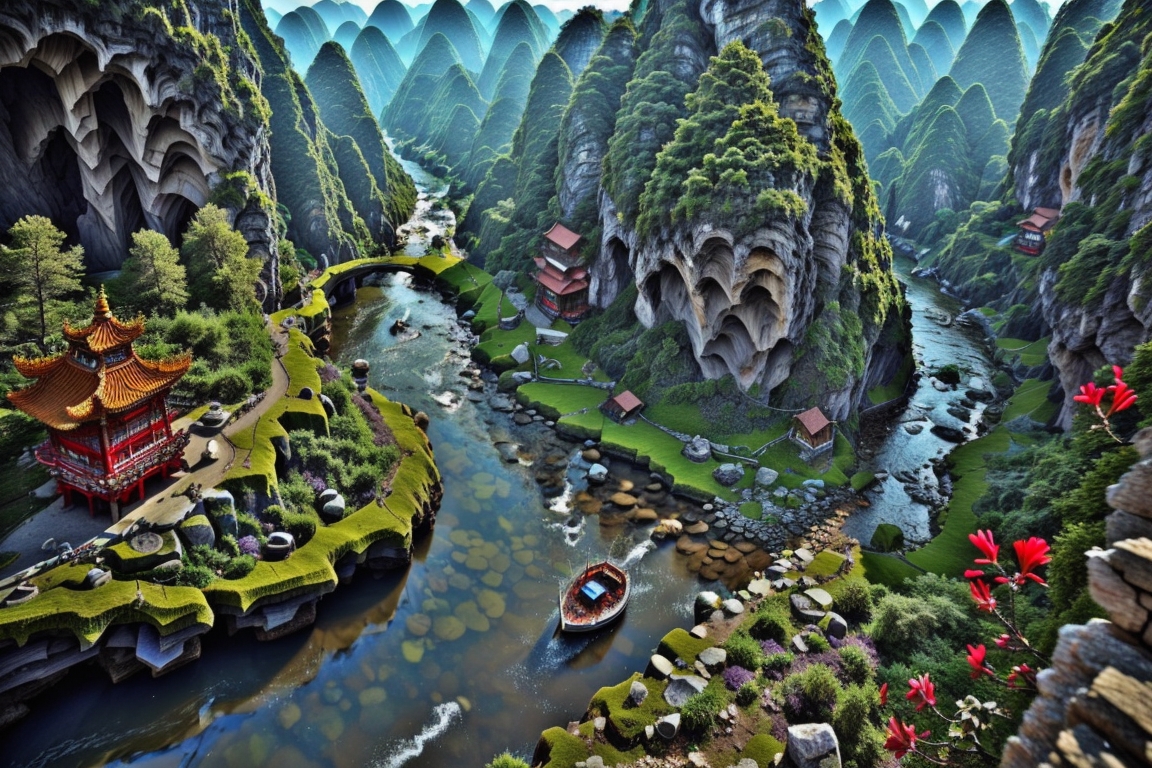Welcome to the vast expanse of China, where traditions birthed in ancient epochs coalesce harmoniously with the bustle of cutting-edge innovation. From the serenity of its mountains to the fervor of its cities, China invites you on a journey through millennia, ready to bewitch you at every twist and turn.
5 Captivating Facts about China
- Pioneers of Paper Currency: Long before the West adopted the convenience of paper money, China had been using it since the 7th century, during the Tang Dynasty. Before this innovative leap, their chief currency was uniquely-shaped coins with a rectangular hole in the center.
- The Esteemed Art of Chinese Calligraphy: Where in many societies, artists often grapple for respect, in China, calligraphy stands as a revered form of art. This centuries-old craft is not merely about writing but expresses the very soul of the artist and has paved the way for various other art forms.
- Football’s Ancient Origins: Though not known for its contemporary football prowess, history suggests that the sport’s roots can be traced back to China, over 2,000 years ago.
- The Central Pillar of Family: An essential facet of Chinese culture is the paramount importance of family. While in the West, children often move out for college or work, in China, the tradition is for families to remain close-knit, often living together across generations.
- The Divine Dragon: Far from the intimidating or malevolent creatures of Western lore, in Chinese culture, dragons symbolize prosperity, power, and good luck. This is vividly illustrated during festivities like the Chinese New Year, where dragon dances are central attractions.
- The Majestic Great Wall: Beyond being just an architectural marvel, the Great Wall of China stands testament to the determination and skill of ancient Chinese civilization. This man-made wonder, visible from space, is a potent symbol of China’s historical might and ingenuity.
Iconic Destinations in the Middle Kingdom
- Forbidden City, Beijing: An architectural marvel, the Forbidden City is an ancient palace complex in Beijing. Once the imperial palace of the Ming and Qing dynasties, it offers a vivid peek into China’s opulent history.
- The Great Wall of China: Stretching over 6,000 kilometers, this iconic symbol of China offers breathtaking views and a tangible link to the country’s past. Each brick and stone narrates tales of ancient dynasties, wars, and the indomitable Chinese spirit.
- West Lake, Hangzhou: Described as ‘paradise on Earth’, the West Lake in Hangzhou is a serene blend of temples, pagodas, and gardens, all complemented by the backdrop of mist-clad mountains.
- Yangshuo County: For those who seek solace in nature, Yangshuo County offers picturesque landscapes, characterized by limestone karsts, serene rivers, and traditional villages.
- Zhangjiajie National Forest Park: Known to inspire the floating mountains in James Cameron’s ‘Avatar’, this park is home to thousands of pillar-like formations, creating a surreal, otherworldly terrain.
- Lhasa, Tibet: A realm of spiritualism and beauty, Lhasa is the epicenter of Tibetan Buddhism. The Potala Palace, Jokhang Temple, and the serene landscapes make Lhasa a haven for seekers of both spirituality and natural beauty.
Tantalizing Chinese Culinary Treasures
Chinese cuisine is as diverse as its terrain. From the spicy flavors of Sichuan to the subtle delicacies of Cantonese food, there’s a plate for every palate. Staples like dumplings and Peking duck are globally beloved, while adventurous foodies might venture to try century eggs or bird’s nest soup. But the true essence of Chinese food lies in its shared experience – be it a family gathering around a hotpot or friends grabbing dim sum on a Sunday morning.
Traditions and Festivities
China’s festivals are a riot of colors, sounds, and flavors. The Chinese New Year, marked by dragon dances and fireworks, celebrates the lunar new year. The Mid-Autumn Festival witnesses families coming together to share mooncakes and admire the full moon. Qingming Festival, or Tomb-Sweeping Day, is a time to honor ancestors, while the Dragon Boat Festival sees competitive boat races and the consumption of zongzi – rice dumplings wrapped in bamboo leaves.
China’s Most Celebrated Holidays and Festivals: A Deep Dive
China’s rich tapestry of culture is best showcased through its numerous holidays and festivals. Steeped in traditions, these occasions reflect the depth of China’s history and its relationship with nature, ancestry, and spirituality.
1. Chinese New Year (Spring Festival)
- Date: First day of the Chinese lunar calendar (usually between January 21 and February 20)
- Traditions: The festival marks the start of the lunar new year and is celebrated with dragon and lion dances, fireworks, family gatherings, and the giving of red envelopes (hongbao) containing money for luck.
- Food: Dumplings (jiaozi) are a must, symbolizing wealth. Also, fish, which phonetically sounds like ‘surplus’ in Chinese, signifies abundance. Other dishes like spring rolls, sticky rice cake, and longevity noodles are also enjoyed.
2. Lantern Festival
- Date: 15th day of the first lunar month (marks the end of Chinese New Year celebrations)
- Traditions: Displaying and admiring colorful lanterns, solving lantern riddles, lion and dragon dances, and walking on stilts.
- Food: Tangyuan (sweet rice balls), symbolizing family unity, are traditionally consumed.
3. Qingming Festival (Tomb-Sweeping Day)
- Date: April 4th or 5th
- Traditions: Honoring and making offerings to ancestors at grave sites, spring outings, and flying kites.
- Food: Green dumplings (Qingtuan), made of glutinous rice and barley grass, are popular during this time.
4. Dragon Boat Festival (Duanwu Festival)
- Date: 5th day of the 5th lunar month (usually in June)
- Traditions: Dragon boat racing to commemorate the ancient poet Qu Yuan. Also, hanging calamus and mugwort on doors to ward off evil spirits.
- Food: Zongzi (sticky rice dumplings wrapped in bamboo leaves) is the hallmark dish, traditionally filled with various fillings like meat, beans, or yolk.
5. Mid-Autumn Festival
- Date: 15th day of the 8th lunar month (usually in September)
- Traditions: Admiring the full moon, lighting lanterns, and family gatherings.
- Food: Mooncakes, dense pastries filled with sweet-bean or lotus-seed paste, often with a salted yolk in the center, representing the moon.
6. National Day
- Date: October 1st
- Traditions: Celebrated to mark the founding of the People’s Republic of China. It begins the “Golden Week”, a seven-day holiday period filled with celebrations and travel.
- Food: No specific dishes are associated, but feasts and banquets are common.
7. Double Ninth Festival (Chongyang Festival)
- Date: 9th day of the 9th lunar month (usually in October)
- Traditions: Climbing mountains, enjoying the scenery, and visiting elders to pay respects.
- Food: Chongyang cake, a type of steamed cake made from rice flour, sugar, and various fillings, is popular.
8. Winter Solstice Festival (Dongzhi Festival)
- Date: Between December 21st and 23rd
- Traditions: Marking the arrival of winter, it’s a time for family gatherings.
- Food: Tangyuan (sweet rice balls) are again consumed, similar to the Lantern Festival but in various preparations, symbolizing the coming together of family.
While these are some of the most celebrated holidays, China’s vastness means regional variations and unique local celebrations abound. From the snowy northern provinces to the tropical south, each region has its own way of marking these special times, making China an endlessly fascinating cultural tapestry to explore.
In Conclusion
China isn’t just a country; it’s a living chronicle of humanity’s journey through time. It promises the traveler a kaleidoscope of experiences, from the contemplative to the exhilarating. So, embrace the adventure, and let China’s wonders unfold before you. Welcome to the land where dragons dance, history breathes, and the future is being crafted today.




